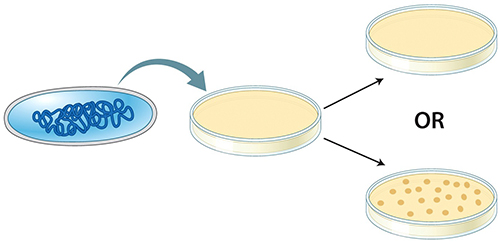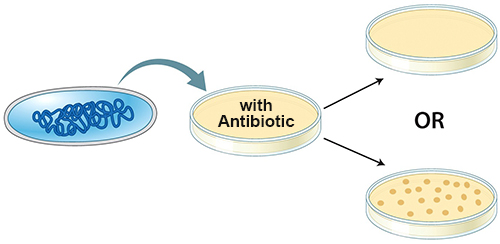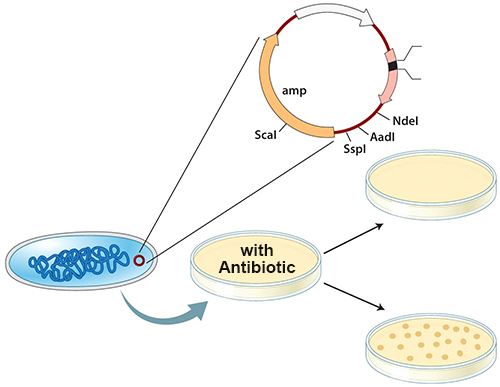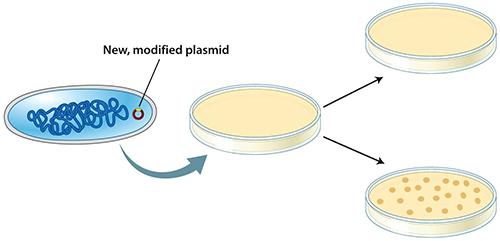Chapter 1. How Do We Know 3.1
Background Information
Figure 3.1: What is the nature of the genetic material?
In 1869, a German chemist, Johann Frederick Miescher, isolated a novel substance from the nuclei of white blood cells. Since it was derived from the nucleus, Miescher named the substance “nuclein." Unlike proteins, this substance had a high concentration of phosphorus along with nitrogen. Miescher’s colleagues tried to convince him that nuclein was just another protein and phosphorus was a contaminant. However, Miescher was very persistent in his belief that nuclein was a new type of molecule. Eventually, chemical analysis revealed that chromosomes are composed of both protein and Miescher’s nuclein, which we now call deoxyribonucleic acid (DNA).
1.
Griffith’s discovery of the transforming principle (Fig. 3.1) and Avery’s subsequent analyses on DNA (Fig. 3.2) illustrated that (choose all that apply):
| DNA is replicated semiconservatively. | |
| DNA is the genetic material. | |
| DNA can move through the cell membrane. | |
| DNA is composed of paired nucleotides. | |
| DNA is responsible for viral infection. |
Hämmerling’s Experiment
Now that you’ve seen how Griffiths answered the question of what the genetic material is, let’s explore another experiment that tried to answer the same question with a different organism.
When nucleic acids were discovered and chemically characterized in the early 1900’s, scientists were unsure about the molecule’s function. Two major groups developed in which one favored the hypothesis that proteins carry genetic information, and the other, smaller group sided with nucleic acids. To settle this debate, key experiments were required. As already discussed, Frederick Griffith’s experiments in 1928 indicated that genetic information can be transferred between bacterial cells, but did not identify the molecule itself. However, follow-up experiments by researchers like Oswald Avery, Colin MacLeod, Maclyn McCarty, and others identified DNA as the genetic material.
Another key follow-up experiment was performed by a Danish-German scientist named Joachim Hämmerling. In the 1930’s and 1940’s, he did experiments using a marine alga (Acetabularia mediterranea) as his model organism. The alga has a very simple anatomy including a cap, stalk, and base, as shown below. The base houses a structure known as the nucleus.
Hämmerling decided to see what would happen if he removed different parts of the alga. He first removed the cap of one alga and allowed it to grow. The organism grew back the cap in the original shape. He then removed the stalk and cap of another alga and allowed it to grow. The organism grew back the stalk and cap in the original shape. Finally, he removed the base of a third alga and allowed the stalk and cap to grow. The baseless alga died.
2.
What was the independent variable in Hämmerling’s experiment?
When performing experiments, researchers manipulate the test group differently than the control groups. The difference is known as a variable. An independent variable is the manipulation performed on the test group and the dependent variable is the effect in the test group after the manipulation has been applied. This may be viewed as a cause and effect relationship, with the independent variable being the cause and the dependent variable being the resulting effect.
What was the independent variable in Hämmerling’s experiment?
| A. |
| B. |
| C. |
| D. |
3.
What was the dependent variable?
When performing experiments, researchers manipulate the test group differently than the control groups. The difference is known as a variable. An independent variable is the manipulation performed on the test group and the dependent variable is the effect in the test group after the manipulation has been applied. This may be viewed as a cause and effect relationship, with the independent variable being the cause and the dependent variable being the resulting effect.
What was the dependent variable?
| A. |
| B. |
| C. |
| D. |
With these initial tests, Hämmerling proposed that something in the base seemed to be controlling cell function and the development of traits. He hypothesized that it must be something in the conspicuous little ball in the base known as the nucleus. With the knowledge from his previous experiments, Hämmerling decided to cut and join (graft) structures from two similar species of Acetabularia (A. mediterranea and A. crenulata). These species are very similar, except that A. mediterranea has a round cap and A. crenulata has a star-shaped cap, as shown below:
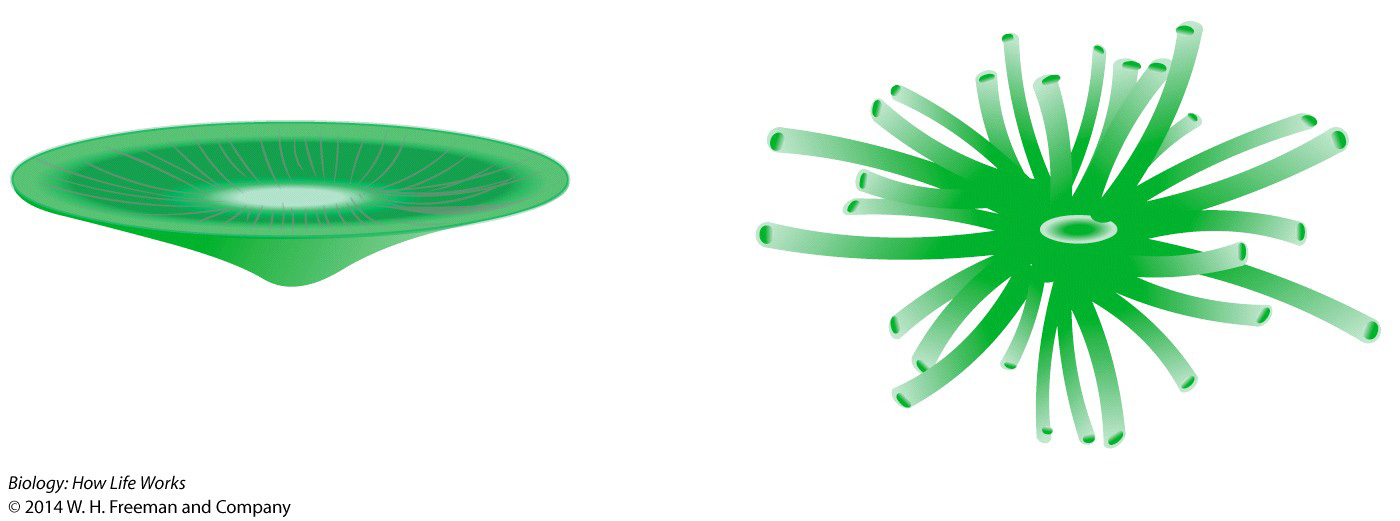
Hämmerling used his initial organism, A. mediterranea, as the base to which he would graft a portion of the new organism, A. crenulata. From A. mediterranea he removed the cap and stalk, leaving only the intact base. From A. crenulata, he removed the cap and base, leaving only the intact stalk. He then grafted the A. crenulata stalk onto the A. mediterranea base.
Hämmerling then watched to see what happened. He found that his hybrid alga first grew back a cap intermediate in shape between A. mediterranea and A. crenulata. When he removed the cap and allowed the alga to grow again, this time it grew back a round cap typical of A. mediterranea.
4.
What can you conclude from these results?
| A. |
| B. |
| C. |
| D. |
| E. |
| F. |
5.
Which of the following is a useful follow-up experiment?
| A. |
| B. |
| C. |
| D. |
6.
What do you predict would be the results of an experiment in which an A. crenulata base was grafted onto an A. mediterranea stalk?
| A. |
| B. |
| C. |
| D. |
Briggs and King’s Experiment
To continue this line of questioning about the nature of the genetic material and its connection with the cell’s nucleus, we need to explore other contributions, such as those by Thomas King and Robert Briggs. Before Briggs and King performed their landmark work, Yves Delage in 1895 first wrote about a theoretical process known as nuclear transplantation (which is a current method of cloning, or making an exact genetic copy of a cell or organism). Delage hypothesized that if the nucleus of an egg were replaced with that of another cell, development might still occur, guided by the genetic information in the transplanted nucleus. However, Delage did not have the technology to perform these experiments. Thomas King and Robert Briggs first tried this type of experiment, using the northern leopard frog, Rana pipiens, as a model organism.
King and Briggs transferred the nucleus of a blastula cell into a fertilized egg whose nucleus was removed. To do so, they inserted a glass pipette into the cell of a frog blastula, an early embryonic stage of development, and removed the cell’s nucleus. They then inserted the nucleus into an egg cell whose own nucleus had been removed (enucleated). The egg with its new nucleus is then allowed to go through normal development.
7.
What is an appropriate negative control for the experiment just described? (Choose all that apply.)
In designing experiments, researchers often set up controlled experiments. In a controlled experiment, several groups are tested simultaneously, keeping almost all variables the same among them. In one group, a single variable is changed, allowing the researcher to see if that variable has an effect on the results of the experiment. This is known as the test group. In another group, the variable is not changed and no effect is expected. This is known as the negative control. Finally, in a third group, a variable is deliberately introduced that has a known effect, to be sure that the experiment is working properly. This is known as the positive control.
For example, if you are interested in whether a new medicine is effective in the treatment of headaches, you may have three groups of patients: one group might receive no medicine (the negative control); one group might receive the new medicine (the test group); and one group might receive a medicine known to be effective against headaches (the positive control). All of the other variables, such as gender, age, socioeconomic background, and the like, would be similar among the three groups. In some cases, researchers even control for the act of giving the medicine. In this case, the negative control might be a placebo, a sugar pill with no pharmacologic effect. In this way, all three groups receive medicine, so the researchers have controlled even for this potential variable.
A. an enucleated egg (nucleus removed) without the introduction of a donor nucleus.
B. an enucleated egg (nucleus removed) with the introduction of sterile water.
C. an unfertilized frog egg that is allowed to develop normally.
D. a fertilized frog egg that is allowed to develop normally.
E. a fertilized frog egg in which the nucleus is removed and then reinserted.
8.
What is an appropriate positive control for the experiment just described? (Choose all that apply.)
In designing experiments, researchers often set up controlled experiments. In a controlled experiment, several groups are tested simultaneously, keeping almost all variables the same among them. In one group, a single variable is changed, allowing the researcher to see if that variable has an effect on the results of the experiment. This is known as the test group. In another group, the variable is not changed and no effect is expected. This is known as the negative control. Finally, in a third group, a variable is deliberately introduced that has a known effect, to be sure that the experiment is working properly. This is known as the positive control.
For example, if you are interested in whether a new medicine is effective in the treatment of headaches, you may have three groups of patients: one group might receive no medicine (the negative control); one group might receive the new medicine (the test group); and one group might receive a medicine known to be effective against headaches (the positive control). All of the other variables, such as gender, age, socioeconomic background, and the like, would be similar among the three groups. In some cases, researchers even control for the act of giving the medicine. In this case, the negative control might be a placebo, a sugar pill with no pharmacologic effect. In this way, all three groups receive medicine, so the researchers have controlled even for this potential variable.
A. removal of the nucleus from a fertilized egg without the introduction of a donor nucleus.
B. removal of the nucleus from a fertilized egg with the introduction of sterile water.
C. an unfertilized frog egg that is allowed to develop normally.
D. a fertilized frog egg that is allowed to develop normally.
E. a fertilized frog egg in which the nucleus is removed and then reinserted.
What is the major independent variable in the experiment just described?
When performing experiments, researchers manipulate the test group differently than the control groups. The difference is known as a variable. An independent variable is the manipulation performed on the test group and the dependent variable is the effect in the test group after the manipulation has been applied. This may be viewed as a cause and effect relationship, with the independent variable being the cause and the dependent variable being the resulting effect.
9.
What is the major independent variable in the experiment just described?
| A. |
| B. |
| C. |
| D. |
| E. |
10.
What is the major dependent variable in the experiment just described?
When performing experiments, researchers manipulate the test group differently than the control groups. The difference is known as a variable. An independent variable is the manipulation performed on the test group and the dependent variable is the effect in the test group after the manipulation has been applied. This may be viewed as a cause and effect relationship, with the independent variable being the cause and the dependent variable being the resulting effect.
What is the major dependent variable in the experiment just described?
| A. |
| B. |
| C. |
| D. |
| E. |
Briggs and King's early attempts failed. However, their later attempts were successful. By the time the experiment was completed, they had successfully obtained 35 embryos and 27 tadpoles from 104 nuclear transplants. As an extension of this work, Briggs, King, and later John Gurdon attempted to transfer nuclei of older embryonic cells and even differentiated cells of tadpoles. Differentiated means that these cells are restricted in the kinds of cells they can become and are developing into specific tissues. Here is an example of the kind of data these researchers obtained:
| Age of donor cell | # of nuclei transferred | # of living tadpoles |
|---|---|---|
| 1 hour | 20 | 10 |
| 12 hours | 20 | 7 |
| 24 hours | 20 | 3 |
| 48 hours | 20 | 0 |
| 72 hours | 20 | 1 |
11.
What can you conclude from these data? (Choose all that apply.)
A. The ability of transplanted nuclei to direct normal development is directly related to the age of the donor cell (as the donor cell nucleus was older, normal development success rate increased).
B. The ability of transplanted nuclei to direct normal development is inversely related to the age of the donor cell (as the donor cell nucleus was older, normal development success rate decreased).
C. Something in the nucleus changes as an animal differentiates, limiting and restricting the ability of the nucleus to direct normal development.
D. The results are difficult to interpret because of the low numbers of living tadpoles obtained in each category and could be improved by more trials.
12.
Based on the results with younger vs. older donor nuclei above, predict the outcome when these same studies were performed with donor nuclei from tadpole (differentiated) cells.
| A. |
| B. |
| C. |
| D. |
13.
Based on what you know about the nucleus and DNA, what do you think the tadpoles that developed from these nuclear transplants resembled?
| A. |
| B. |
| C. |
| D. |
14.
Based on the data, what do you predict would be the number of living tadpoles that result from nuclei transferred from a donor cell that is 96 hours old? Why?
| A. |
| B. |
| C. |
| D. |
DIY Experiment
Let's now try an experiment that will give us more information about the nature of the genetic material.
Prokaryotes are types of cells that lack organelles (specialized membrane-bound structures that perform specific functions for the cell), such as bacteria. Because they lack organelles, their DNA is not enclosed in any structure. This genomic DNA contains instructions necessary for daily function. Prokaryotes sometimes have small circular pieces of DNA in addition to their genomic DNA. These are called plasmids.
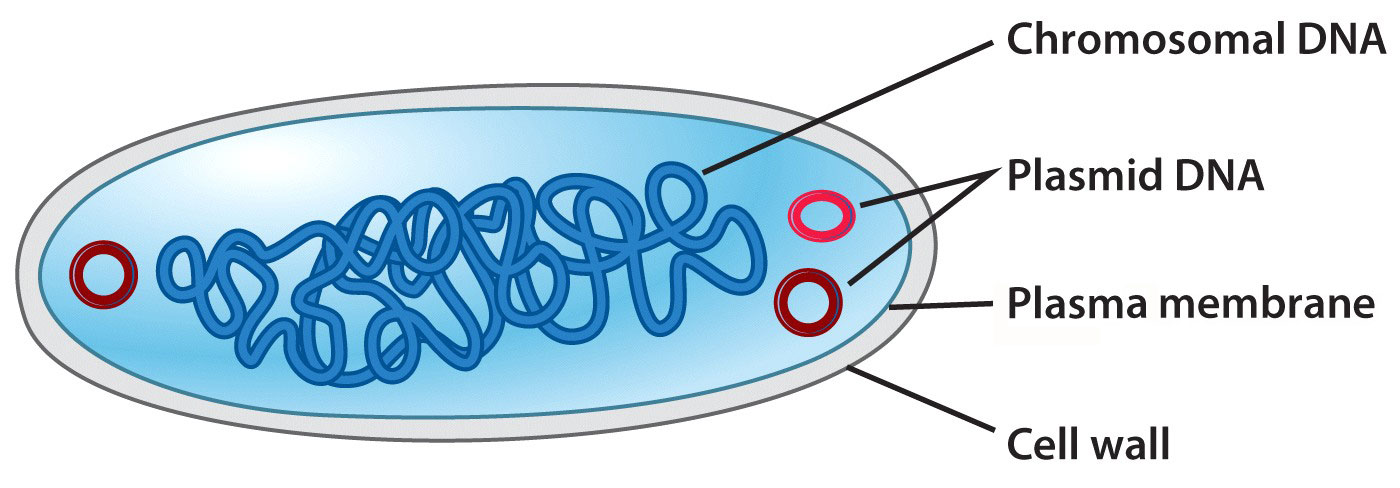
Plasmid DNA can be released and then taken up by a new bacterial cell, or artificially manipulated and introduced into a bacterial cell in the lab, thereby giving the recipient bacteria new capabilities and traits the cell did not originally have. For example, genes that confer antibiotic resistance are often carried on plasmids. The process by which a cell takes up foreign DNA is known as transformation.
15.
Suppose we have a bacterial cell with only the “basic” genomic DNA needed for life’s processes. Bacteria are grown in the lab by mixing cells in solution and then spread on medium containing food necessary for their growth and reproduction (sterile growth medium). Though bacteria are too small to see individually, we can see if bacteria have grown by observing the growth or absence of bacterial colonies—groups of bacteria that result from the replication of a single bacterium.
In this case, we attempt to grow the bacteria on a sterile plate with growth media at the appropriate temperature in darkness (in other words, under ideal conditions). Click on the plate that shows what would happen:
16.
Suppose we now take this same bacterial cell and attempt to grow it on a sterile media growth plate embedded with an antibiotic. Click on the plate that shows what would happen:
{"title":"No Growth","description":"Correct. This is the negative control. The antibiotic kills the cells.","type":"correct","color":"#99CCFF","code":"[{\"shape\":\"rect\",\"coords\":\"365,2,499,76\"}]"} {"title":"Growth","description":"Try again. Would the presence of an antibiotic be conducive to bacterial growth, especially if the bacteria did not carry genes conferring antibiotic resistance?","type":"incorrect","color":"#99cc00","code":"[{\"shape\":\"rect\",\"coords\":\"361,166,499,242\"}]"}
Now let’s introduce a plasmid into the environment. This plasmid has a gene for resistance to the antibiotic ampicillin. This means that this plasmid has a DNA sequence which would allow for resistance to ampicillin, an antibiotic. This plasmid is now transformed into a bacterial cell.
17.
What will happen if this transformed cell is placed onto a sterile growth media plate without the ampicillin antibiotic? Click on the plate that shows what will happen.
{"title":"Growth","description":"Correct. The cells will grow with or without the addition of the plasmid carrying the ampicillin resistance gene.","type":"correct","color":"#99CCFF","code":"[{\"shape\":\"rect\",\"coords\":\"362,311,498,383\"}]"} {"title":"No Growth","description":"Incorrect. Try again.","type":"incorrect","color":"#99cc00","code":"[{\"shape\":\"rect\",\"coords\":\"365,149,498,221\"}]"}18.
What will happen if this transformed cell is placed onto a sterile growth media plate with the ampicillin antibiotic?
{"title":"Growth","description":"Correct. The cells now have additional \"information\" in the form of the plasmid with the gene for ampicillin resistance, and can grow on the ampicillin plate.","type":"correct","color":"#99CCFF","code":"[{\"shape\":\"rect\",\"coords\":\"362,311,498,383\"}]"} {"title":"No Growth","description":"Try again. Transformed bacteria carry a DNA sequence that confers antibiotic resistance. Would this confer an advantage for bacteria plated on ampicillin-treated plates?","type":"incorrect","color":"#99cc00","code":"[{\"shape\":\"rect\",\"coords\":\"365,149,498,221\"}]"}19.
From this experiment, you can conclude that:
| A. |
| B. |
| C. |
| D. |
20.
What might you conclude if nothing grew on any of the plates?
| A. |
| B. |
| C. |
| D. |
21.
The plasmid we are using has a site in the middle of the ampicillin resistance gene that the enzyme ScaI can recognize and cut. In an experiment, this enzyme was used prior to the plasmid’s transformation, causing the circular plasmid DNA to open up. Next, a small segment of DNA was inserted into the cut site, closing the circle once again. This modified plasmid was then transformed into a bacterial cell.
Predict what the results might be on a sterile plate.
22.
Predict what the results might be on a plate with ampicillin.
{"title":"No Growth","description":"Correct. Since the DNA region coding for ampicillin resistance is interrupted, the cell will lose its resistance and die when placed onto the ampicillin antibiotic plate.","type":"correct","color":"#99CCFF","code":"[{\"shape\":\"rect\",\"coords\":\"362,1,497,75\"}]"} {"title":"Growth","description":"Incorrect. Note that ScaI treatment renders the plasmid’s gene for ampicillin resistance ineffective. Would this result in antibiotic-resistant bacteria? ","type":"incorrect","color":"#99cc00","code":"[{\"shape\":\"rect\",\"coords\":\"364,166,499,239\"}]"}Activity results are being submitted...
